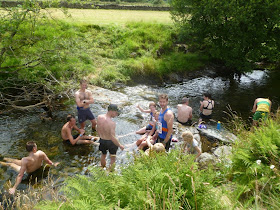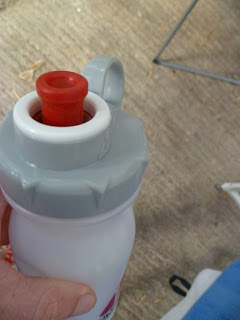Sometimes you have good races. The more good races you have, the worse the bad races seem, and today was a pretty horrible one.
I had a bit of a feeling that this might be tough. Just an inkling of a feeling, but I knew the heat was not going to make this an easy race.
It is marked out at as a Medium length race, and has the distinction of being the longest "medium" in the FRA calendar. Organised by the famous Mr Bland, and also in the Glossopdale club championships, it would have been rude not to do the race, no matter how I was feeling about it.
Having got there early, I bobbed out along the final kilometre or 2, just to check the run in, and sent Lynne off on her own magical mystery tour of the area, as she wasn't racing.
At the start I felt like I didn't want to be too near the front of the pack as I would probably get drawn into starting out too fast, so I sneaked back a little way, to start with the rest of the Glossopdale guys.

The beginning of the race was up a road, and then a gradually steepening path. Looking at the profile, it was
a greater incline that that of Foel Fras. Although Foel Fras was longer, with more climb, this was destined to be a harder race, physically and mentally.
To begin with I was feeling ok, not too bad at all, and was passing a few people that may have started a little too close to the front of the pack for their own good.
Then it began to get steep and my legs began to complain. They got heavy, and then runners started to go past me. Looking ahead, there were maybe 20 to 30 racers in front of me, doing their thing, running up the steep part of this part of the climb. As much as I tried, as much as I wanted to, as much as I told my legs to shut up and do their thing, I ended up walking.
Already.
Not a good sign.
The rest of the climb up was basically spent in conversation with myself about whether my training had been too much over the last couple of weeks... or maybe too little running? or maybe I hadn't eaten properly? not recovered well enough? or maybe there was something else going on? Surely other people couldn't be suffering as much as me?
Runner after runner was passing me, looking stronger and running with more poise and strength than I could possibly muster.
 |
| A lovely view, looking up toward a part of the route |
Originally I was hoping for a time in the region of 1:50 or so, something comparable to Foel Fras, but with the way I was feeling, that was probably going to be slipping away. I contemplated sitting down and looking at the view. I contemplated just turning around and wandering back down the hill. I contemplated just stopping.
But you can't. Everyone else probably feels that way as well, so you just have to keep grinding. Keep moving. I won't call it running, or else I might get done on the trade descriptions act.
Got to the top, slowly sipping through my drink, basically suffering all the way. Legs not moving right, really not feeling great, wanting to stop at every opportunity, and having to walk far, far more than I ever did at Foel Fras. On the turn back down the hill from High street I downed a coffee energy gel, hoping against hope that the fatigue and heaviness in my legs might be remedied by a double shot of espresso and a whole load of sugar.
It didn't entirely work, but I managed to carry on, and put some distance between me and the guy that was
finally catching me on the last part of the climb. At this point, all I wanted was for the race to be finished, especially as the course was not entirely all downhill from this point. Still eminently runnable, for those with more strength and ability than myself on this particular day, but certainly not for me.
Down the paths, across the fields, still haemorraging places to other runners. It was not a good day.
It was only at the final plunge downhill, across some rougher grass that I got annoyed enough with myself and the people that kept passing me and pelted through the long grass, passing 2 others who were going down the trod in the middle of the field. That felt good.
 |
| Chasing down in the last few metres |
Then a grind through trails and into the final part of the race. Everything hurting, nothing easy about it, and even more encouragement from the brain to just sit down, yet with 2 guys just in front of me, and with one of them weakening, there was no way that was going to happen.
I clung on to the faster of the 2 guys all the way to the end, chasing him down in a final sprint, getting into the finishing funnel at exactly the same time as him, according to the results sheet, but with him in front of me in the funnel.
Well done to the Glossopdale Girls though.... they came out with 1st Ladies team, and ended up with Pete Bland vouchers... Nice!
 |
| Recovery in the stream |
Despite the fact that I felt like I was running so slowly, I still managed to come in at 1:53, which is about where I was expecting. Descending is still waaaay better than ascending, and it will take a long time and a LOT of training to get better, stronger and more comfortable with climbing. Thats going to take a while.
The odd thing was that I didn't feel like I was tired from a hard run, I just felt generally fatigued about the entire run. No speed, no strength, no heart - not race fatigue, generic fatigue.
 |
| Cake |
 |
| Glossopdale enjoying the stream |
What is important now, is recovery, analysis, and putting that knowledge into training. And getting better.




















